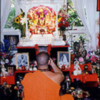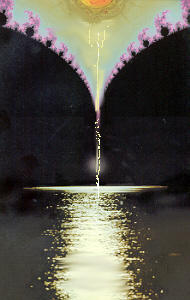 ...To the best of my knowledge, a comparative study of the epistemological theories of the mental processes involved in mystical experience in different religions has not been attempted so far.
...To the best of my knowledge, a comparative study of the epistemological theories of the mental processes involved in mystical experience in different religions has not been attempted so far.In the works of the great mystics we come across wonderful descriptions of the vision of God and other mystical experiences but hardly any mention of the mental processes which produce these experiences. It is the commentators, theologians and philosophers who work out the epistemological theories regarding these experiences. Apart from explaining how mystical experiences take place, they have also to explain why all people do not get such experiences. If God is all-pervading, why is it that we don’t see Him?
...it is often claimed that mysticism is the same in all ages and in all places, that timeless and independent of history, it has always been identical. East and West and other differences vanish here. Whether the flower of mysticism bloom in India or in China, in Persia or on the Rhine, its fruit is one...
...The mystical experiences of St. Teresa and Mirabai, of St. John of the Cross and Tukaram, of Sankara and Eckhart are not the same. According to some scholars(5) these differences are due to the influence of the cultures of the mystics. The present paper attempts to show that there are also basic differences in the epistemological pre-suppositions regarding mystical experience in Christianity and Hinduism.
Mysticism in Relation to Forms of Knowledge
Before discussing the nature of mystical experience, it is necessary to place it in the right perspective in Western thought and Indian thought.
In Western thought we are here concerned only with those views which accept the validity and cognitive import of religious experience. (There are other views, such as Logical Positivism, Marxism and certain forms of realism, which deny this.) These views fall into two groups. According to the first group, the apprehension of the Divine is the result of inference from, or interpretation of, religious experience. They accept the validity of religious experience but deny that it can be understood as wholly immediate and self-evident, as it needs analysis and critical interpretation.
The second group takes religious experience to be an immediate and self-authenticating encounter with the Divine. However, there are two kinds of immediacy: revelational and mystical. Revelational immediacy pertains to the peculiar ability of the human mind to apprehend God in the form of an insight or certitude. This is usually regarded as a higher form of faith, but is also known as “religious a priori”. The German Protestant theologian Schleiermacher was one of the first to propound this kind of religious experience. Later on Emil Brunner and several other Protestant theologians spoke of the “divine-human encounter”, and Martin Buber spoke of religious experience as an “I-Thou” relationship.
The other type of immediacy known as mystical immediacy refers to the direct experience of God obtained by transcending the senses through contemplation. This is what is called mysticism. Its validity is accepted by Roman Catholic and Eastern Churches.
The dominant and living system of philosophy in Hinduism is the Vedanta, which is divided into several schools. All these schools accept at least three main pramanas (valid means of knowledge), viz. perception (pratyaksha), inference (anumana), and verbal testimony (sabda). Of these, perception alone is regarded as a direct (aparoksha) means; the other two means give rise only to indirect or mediate (paroksha) knowledge.(6) However, all these three “means” of knowledge refer only to empirical knowledge.(7) Mystical knowledge is different from these. Mystical knowledge of the ultimate Reality is not considered a “means of knowledge” but its supreme end.(8) The relation between the above three “means” (pramana) of knowledge and mystical experience of the ultimate Reality has not been properly clarified by Vedanta teachers. A noted authority, Prof. T. M. P. Mahadevan, says, “The knowledge of the self that is said to liberate the soul from bondage is direct knowledge, which is like perceptual knowledge. Only, even perceptual knowledge is not so immediate as self-knowledge. In sense-perception there is the intervention of a sense-organ between subject and object.” (9)
Types of Mystical Experience
The word “mystic” is said to be derived from the Greek mystikos, which means “of the mysteries”, which in its turn is derived from the Greek word mystos, “keeping silence” (akin to Sanskrit mouna). William James in his celebrated work Varieties of Religious Experience has given the “four marks” of the mystic state: ineffability, noetic quality, transiency, and passivity. According to Evelyn Underhill, the chief characteristics of mysticism are practicality, transcendence, love, and a sense of oneness.
We may, however, define mysticism as the transcendent, life-transforming experience of the ultimate Reality.
 The word “transcendent” in the definition distinguishes mysticism from ordinary empirical experiences; the word “life-transforming” refers to its pragmatic import; and “ultimate Reality” distinguishes mysticism from clairvoyance and other extra-sensory or psychic phenomena.
The word “transcendent” in the definition distinguishes mysticism from ordinary empirical experiences; the word “life-transforming” refers to its pragmatic import; and “ultimate Reality” distinguishes mysticism from clairvoyance and other extra-sensory or psychic phenomena.Three types of mysticism are usually recognized: Nature mysticism, God mysticism, and Soul mysticism. Christian mysticism has always been God mysticism. All three types are found in Hinduism. Perhaps the earliest type was Nature mysticism, as shown by many hymns in the Rig-Veda. But this was soon completely superseded by the Soul mysticism of the Upanishads and God mysticism of Bhakti schools.
Mysticism is also divided into two main pathways: the path of love and divine Grace, and the path of knowledge and self-effort, which are known respectively as Bhakti-marga and jnana-marga in Hinduism. Though called marga or path, they are based on quite different ontological pre-suppositions regarding the nature of God and human destiny. Hinduism is the only religion in which these two paths have been recognized as two independent highways and have co-existed as such from time immemorial. Christian mysticism has developed mostly along the path of love and grace, though some elements of the path of knowledge have been integrated into it by mystics like Meister Eckhart and Ruysbrock.

Vedanta Society of Northern California
quote:• The Undivided Life by Swami Bhajanananda
Part One (posted 01/02)
Part Two (posted 02/02)
• Transformation and Transcendence by Swami Bhajanananda
Part One (posted 3/02)
Part Two (posted 4/02)
• The Psalms of David by Rabbi Asher Block (posted 5/02)
• Knowledge and Understanding by Aldous Huxley
Part One (posted 06/02)
Part Two (posted 07/02)
Part Three (posted 08/02)
• Yoga—True and False by Swami Prabhavananda (posted 9/02)
• Teachings of Sri Sarada Devi, the Holy Mother compiled by a Monk of the Ramakrishna Order
Part One (posted 10/02)
Part Two (posted 11/02)
• Reflections on Some Teachings of Christ by Swami Prabhavananda (posted 12/02)
• Fruits of Spiritual Practice by Swami Pavitrananda (posted 1/03)
• The Message of the Chandi by Devadatta Kali (posted 2/03)
• The Healing Power of Silence by Swami Shraddhananda (posted 3/03)
• Sri Ramakrishna the Unknown by Swami Bhajanananda (posted 4/03)
• Our Immortal Self by Swami Shraddhananda (posted 5/03)
• Overcoming Obstacles in Spiritual Life by Swami Yatiswarananda
Part One (posted 6/03)
Part Two (posted 7/03)
• The Ego and the Self by Swami Shraddhananda (posted 8/03)
• Conversations with Swami Turiyananda recorded by Swami Raghavananda and translated by Swami Prabhavananda
Part One (posted 9/03)
Part Two (posted 10/03)
Part Three (posted 11/03)
Part Four (posted 2/04)
Part Five (posted 3/04)
• Christ the Messenger by Swami Vivekananda
Part One (posted 12/03)
Part Two (posted 1/04)
http://www.MonasticDialog.com
What is MID?
Monastic Interreligious Dialogue (MID) is an organization of Benedictine and Trappist monks and nuns committed to fostering interreligious and intermonastic dialogue at the level of spiritual practice and experience between North American Catholic monastic women and men and contemplative practitioners of diverse religious traditions.
Maranatha: A Christian Meditation Mantra
Maranatha
"Ma-Ra-Na-Tha"
"Come Lord"
MARANATHA MANTRA: The teachings of Yoga Meditation are universal and non-sectarian, as is my personal orientation. However, being of
Western birth, I mostly meet people who were born into Christian
families, since Christianity is the dominant religion of the culture where I live. For those who follow Christianity, it is very useful to be aware of the Maranatha Mantra, an ancient mantra of Christian tradition.
See also the article: Yoga and Christianity http://www.swamij.com/yoga-christianity.htm
DIVERSITY OF MANTRAS: Mantra is a very useful practice in Yoga
Meditation. While many, possibly most, of the practitioners of Yoga Meditation who use a mantra use Sanskrit mantras, the science of Yoga Meditation itself does not tell you what mantras to use. The mantra might be in Sanskrit or any other language, either one's native tongue or the language of one's chosen religion. Some of the more brief meditation mantras are simply sound vibrations that are not from any particular language, though being root sounds of languages. These are called seed or bija mantras. Often the mantra is prescribed by one's teacher or lineage, or is practiced in accordance with one's religious affiliation. Or it might be a universal mantra such as the Soham mantra. The Himalayan tradition uses a diversity of mantras for meditation, and also encourages people to follow the teachings, traditions, and mantras of their own religion.





